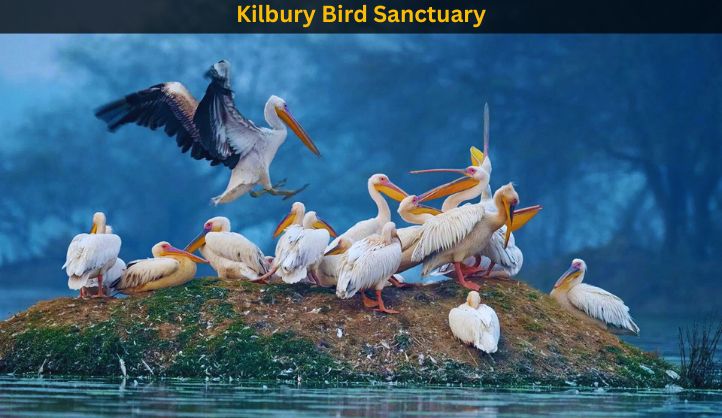Nestled amidst the picturesque landscape of the Himalayan foothills lies an ecological gem, the Kilbury Bird Sanctuary. Tucked away in the quaint town of Nainital, Uttarakhand. The Kilbury Bird Sanctuary is a haven for avian enthusiasts and nature lovers alike. This picturesque paradise, situated at an elevation of approximately 2528 meters, boasts a rich tapestry of biodiversity, with its dense forests teeming with an astounding variety of over 580 bird species.
A Symphony of Feathers
The very air in Kilbury vibrates with the melodious symphony of birdsong. From the elusive collared grosbeaks and the comical forktails to the wise brown wood owls and the melodious white-throated laughing thrushes, the sanctuary offers a breathtaking glimpse into the vibrant world of Indian avifauna. Birdwatchers can lose themselves in the captivating sight of these feathered jewels flitting through the emerald canopy, their plumage a kaleidoscope of colors against the backdrop of the majestic Himalayas.
How to reach the Sanctuary
By Air
The nearest airport to Kilbury Bird Sanctuary is the Pantnagar Airport, located approximately 81 kilometers away. From Pantnagar, one can hire a taxi or take a bus to reach Nainital, the nearest major town to the sanctuary.
By Train
The nearest railway station to Kilbury is Kathgodam Railway Station, situated around 47 kilometers away. Kathgodam is well-connected to major cities like Delhi, Lucknow, and Dehradun via regular train services. From Kathgodam, one can hire a taxi or board a bus to Nainital, and then proceed to Kilbury.
By Road
Nainital, located about 11 kilometers from Kilbury, serves as the gateway to the sanctuary. The town is well-connected to major cities in North India by a network of roads. One can drive to Nainital or opt for bus services operated by state transport or private agencies. From Nainital, taxis or shared jeeps are available for the onward journey to Kilbury Bird Sanctuary.
Map of Kilbury Bird Sanctuary
A Haven for Photography
For photography aficionados, Kilbury presents a treasure trove of opportunities to capture the essence of nature. From the mesmerizing display of birdlife to the breathtaking panoramas of the Himalayas, the sanctuary provides a canvas for photographers of all skill levels. The vibrant hues of the birds, the play of light and shadow on the forest floor, and the majestic snow-capped peaks make for unforgettable photographic memories.
A Glimpse into Local Culture
A visit to Kilbury is not just about experiencing the wonders of nature, but also about immersing oneself in the rich cultural tapestry of the region. Local villages nestled near the sanctuary offer a glimpse into the traditional way of life of the Kumaoni people. Visitors can interact with the warm and welcoming locals, sample their delectable cuisine, and learn about their age-old practices that are deeply intertwined with the environment.
Conservation Efforts and Challenges
Despite its ecological significance, Kilbury Bird Sanctuary faces numerous challenges. Habitat destruction, poaching, and human encroachment pose serious threats to the sanctuary’s biodiversity. Conservation efforts led by local authorities, NGOs, and passionate individuals aim to mitigate these challenges through habitat restoration, community engagement, and awareness campaigns. Sustainable tourism practices and responsible behavior are crucial in ensuring the sanctuary’s long-term survival.
Exploring Beyond Birdwatching
While birdwatching remains the primary attraction, Kilbury offers a myriad of activities for nature lovers. Hiking trails lead to panoramic viewpoints, offering breathtaking vistas of the surrounding mountains and valleys. Picnic spots nestled amidst the woods provide a serene setting for relaxation and contemplation. Nature photography enthusiasts will find endless opportunities to capture the beauty of the sanctuary’s flora and fauna.
Conservation Awareness and Education
Education and awareness play a pivotal role in the conservation of Kilbury Bird Sanctuary. Interpretive centers and guided tours educate visitors about the sanctuary’s ecological significance, threats to biodiversity, and conservation efforts. School outreach programs engage students in environmental conservation, fostering a sense of responsibility towards nature from a young age. By nurturing a deeper understanding and appreciation for the sanctuary’s biodiversity, these initiatives pave the way for its long-term protection.
Nearby Places to Explore
Nainital
Nainital, often referred to as the “Lake District of India,” is a charming hill station situated around 12 kilometers from Kilbury Bird Sanctuary. Famous for its emerald lakes, lush forests, and colonial architecture, Nainital offers a range of attractions including:
- Naini Lake – The Naini Lake is the centerpiece of Nainital, this picturesque lake is surrounded by hills and offers boating opportunities.
- Naina Devi Temple – Perched atop Naina Hill, this sacred Hindu temple dedicated to Goddess Naina Devi offers panoramic views of the surrounding landscape.
- Snow View Point – Accessible by cable car or trekking, Snow View Point provides breathtaking views of the Himalayas.
- Tiffin Top – Also known as Dorothy’s Seat, this viewpoint offers panoramic vistas of Nainital and the surrounding peaks.
Pangot and Sonanadi Wildlife Sanctuary
Located around 7 kilometers from Kilbury, Pangot is a quaint village renowned for its rich avifauna and serene ambiance. It serves as the gateway to the Sonanadi Wildlife Sanctuary, a part of the larger Jim Corbett Tiger Reserve. Birdwatching enthusiasts can explore Pangot’s dense forests and meandering trails in search of elusive avian species.
Bhimtal
Situated approximately 34 kilometers from Kilbury, Bhimtal is known for its pristine lake, Bhimtal Lake, surrounded by lush greenery and hills. Visitors can enjoy boating, birdwatching, and serene walks along the lakeshore. The Bhimtal region also offers opportunities for trekking and exploring nearby attractions like Hidimba Parvat and Nal Damyanti Tal.
Sattal
Located around 33 kilometers from Kilbury, Sattal is a group of interconnected freshwater lakes nestled amidst oak and pine forests. The area is renowned for its biodiversity, offering excellent birdwatching opportunities. Adventurous souls can indulge in activities like kayaking, zip-lining, and trekking while soaking in the natural beauty of the surroundings.
Ranikhet
Ranikhet, situated approximately 67 kilometers from Kilbury, is a picturesque hill station known for its tranquil ambiance and panoramic views of the Himalayas. Attractions in Ranikhet include the Jhula Devi Temple, Chaubatia Orchards, and the majestic views from places like Majhkhali and Bhalu Dam.
Mukteshwar
Perched at an altitude of around 2,285 meters, Mukteshwar offers stunning views of the snow-capped peaks of the Himalayas. Around 65 kilometers from Kilbury, this serene hill station is known for its scenic beauty, fruit orchards, and the centuries-old Shiva Temple. Adventure enthusiasts can also indulge in activities like rappelling and rock climbing.
Conclusion
In a world increasingly disconnected from nature, sanctuaries like Kilbury serve as invaluable sanctuaries for wildlife and sanctuaries for the soul. With its diverse avian population, pristine forests, and breathtaking vistas, Kilbury Bird Sanctuary offers a respite from the chaos of urban life and invites visitors to reconnect with the natural world. As we strive to protect and preserve our planet’s biodiversity, places like Kilbury stand as beacons of hope, reminding us of the beauty and importance of our natural heritage.
FAQs about Kilbury Bird Sanctuary
1. What is the best time to visit Kilbury Bird Sanctuary?
The best time to visit Kilbury Bird Sanctuary is during October to March when the weather is pleasant, and bird activity is at its peak. Winter months, in particular, are ideal for spotting migratory birds, while spring offers the added charm of blooming rhododendrons.
2. Are there any accommodation options near Kilbury Bird Sanctuary?
While there are limited accommodation options within the sanctuary itself, visitors can find a range of hotels, guesthouses, and resorts in nearby towns like Nainital and Pangot. It’s advisable to book accommodations in advance, especially during peak tourist seasons.
3. What should I carry while visiting Kilbury Bird Sanctuary?
Essential items to carry include binoculars or a camera for birdwatching and wildlife photography, comfortable walking shoes for exploring trails, weather-appropriate clothing, sunscreen, insect repellent, and a refillable water bottle. It’s also recommended to carry some snacks and packed meals, especially if planning extended birdwatching sessions.
4. Are there any entry fees or permits required to visit Kilbury Bird Sanctuary?
As of the last available information, there is no entry fee for visiting Kilbury Bird Sanctuary. However, visitors are advised to check for any updates on entry regulations and permits before planning their visit. Additionally, donations towards conservation efforts are always welcome to support the maintenance of the sanctuary.
5. What are the popular birdwatching trails in Kilbury Bird Sanctuary?
Kilbury Bird Sanctuary offers several well-marked trails that cater to both novice and experienced birdwatchers. Popular trails include the Oak Tree Trail, Pine Forest Trail, and Rhododendron Trail, each offering unique birdwatching experiences amidst diverse habitats. Visitors can also opt for guided nature walks conducted by local experts for a more immersive experience.





